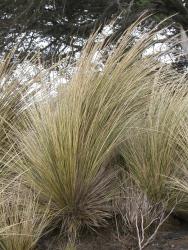- Taxon
- Gallery
- ≡ Dichelachne stipoides Hook.f., Bot. Antarct. Voy. II. (Fl. Nov.-Zel.) Part I, 249, t. 66 (1853)
- ≡ Stipa stipoides (Hook.f.) Veldkamp (1974)
- = Stipa teretifolia Steud. (1854)
Tall, caespitose, stiff, erect perennial with swollen bases occasionally with elongating basal internodes and branching at nodes; branching intravaginal; cataphylls small. Leaf-sheath to 25 cm, smooth, very short hairs often between ridges. Ligule 3–7 mm, decurrent, symmetrical or asymmetrical, nerved, subacute. Leaf-blade to 60 cm × 0.7 mm diam., rigid, folded but appearing terete, abaxially glabrous, sharply acicular, adaxially with abundant short white hairs and some prickle-teeth towards base. Culm to 1 m, internodes glabrous, nodes concealed. Panicle to 20 cm, narrow; branches ascending; rachis, branches and pedicels glabrous. Glumes ± equal, to 20 mm, 3-nerved, produced into awn-like processes ± 1 mm, or acuminate, > awn column. Lemma 8–10 mm long, fuscous, hairs white or brown (± 2 mm), lobes hairy, 1–2 mm; coma to 3 mm; awn to 35 mm, short stiff hairy, 1-geniculate, column strongly twisted to 10 mm, arista to 25 mm. Palea with abundant long internerve hairs, few elsewhere, entire or shallowly lobed, apex shortly ciliate. Callus to 1.5 mm, hairs to 1.5 mm. Lodicules 3, usually 1–2-nerved, acute, ligulate, to 2.5 mm, often 1- or 2-fid, adhering to caryopsis. Anthers apically and basally caudate, to 7.0 mm. Plate 5C.
[From: Edgar and Connor (2000) Flora of New Zealand. Volume 5 (second printing).]




